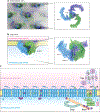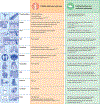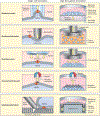The Form and Function of PIEZO2
- PMID: 34153212
- PMCID: PMC8794004
- DOI: 10.1146/annurev-biochem-081720-023244
The Form and Function of PIEZO2
Abstract
Mechanosensation is the ability to detect dynamic mechanical stimuli (e.g., pressure, stretch, and shear stress) and is essential for a wide variety of processes, including our sense of touch on the skin. How touch is detected and transduced at the molecular level has proved to be one of the great mysteries of sensory biology. A major breakthrough occurred in 2010 with the discovery of a family of mechanically gated ion channels that were coined PIEZOs. The last 10 years of investigation have provided a wealth of information about the functional roles and mechanisms of these molecules. Here we focus on PIEZO2, one of the two PIEZO proteins found in humans and other mammals. We review how work at the molecular, cellular, and systems levels over the past decade has transformed our understanding of touch and led to unexpected insights into other types of mechanosensation beyond the skin.
Keywords: PIEZO2; ion channel; mechanosensation; mechanotransduction; proprioception; somatosensation; touch.
Figures




References
-
- Iggo A, Andres KH. 1982. Morphology of cutaneous receptors. Annu. Rev. Neurosci. 5:1–31 - PubMed
-
- Sherrington C 1906. The Integrative Action of the Nervous System. New Haven: Yale Univ. Press
-
- Burgess P, Petit D, Warren RM. 1968. Receptor types in cat hairy skin supplied by myelinated fibers. J. Neurophysiol. 31:833–48 - PubMed
Publication types
MeSH terms
Substances
Grants and funding
LinkOut - more resources
Full Text Sources
Other Literature Sources
Miscellaneous

